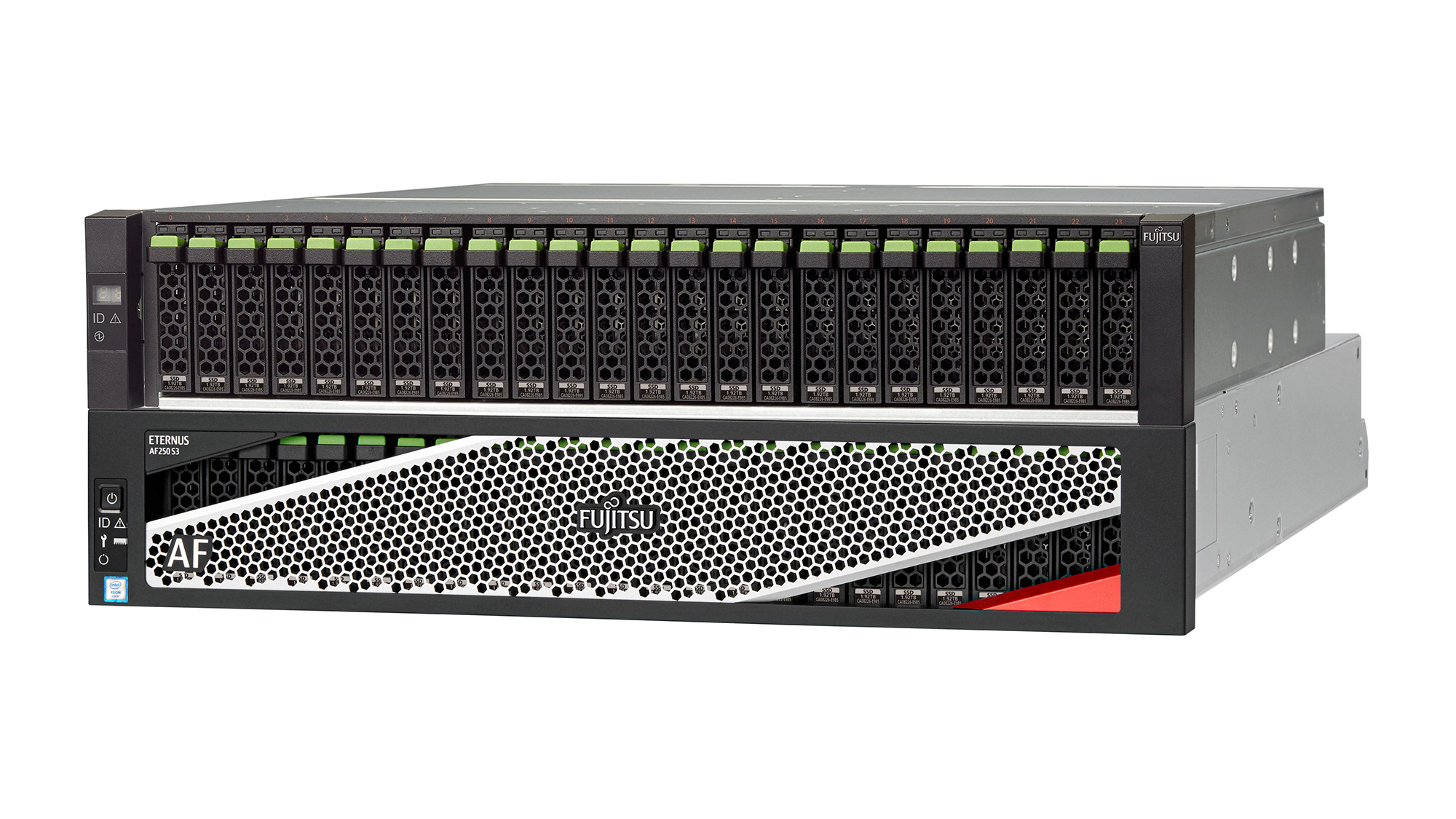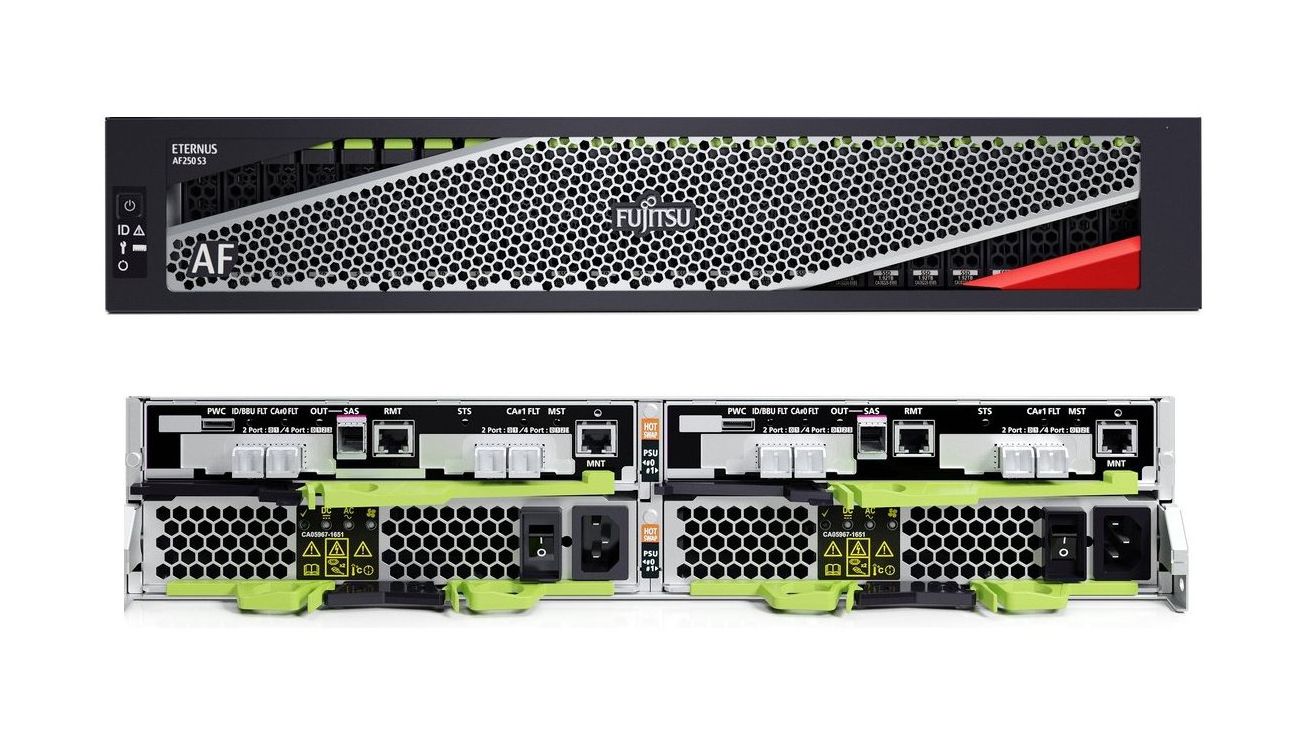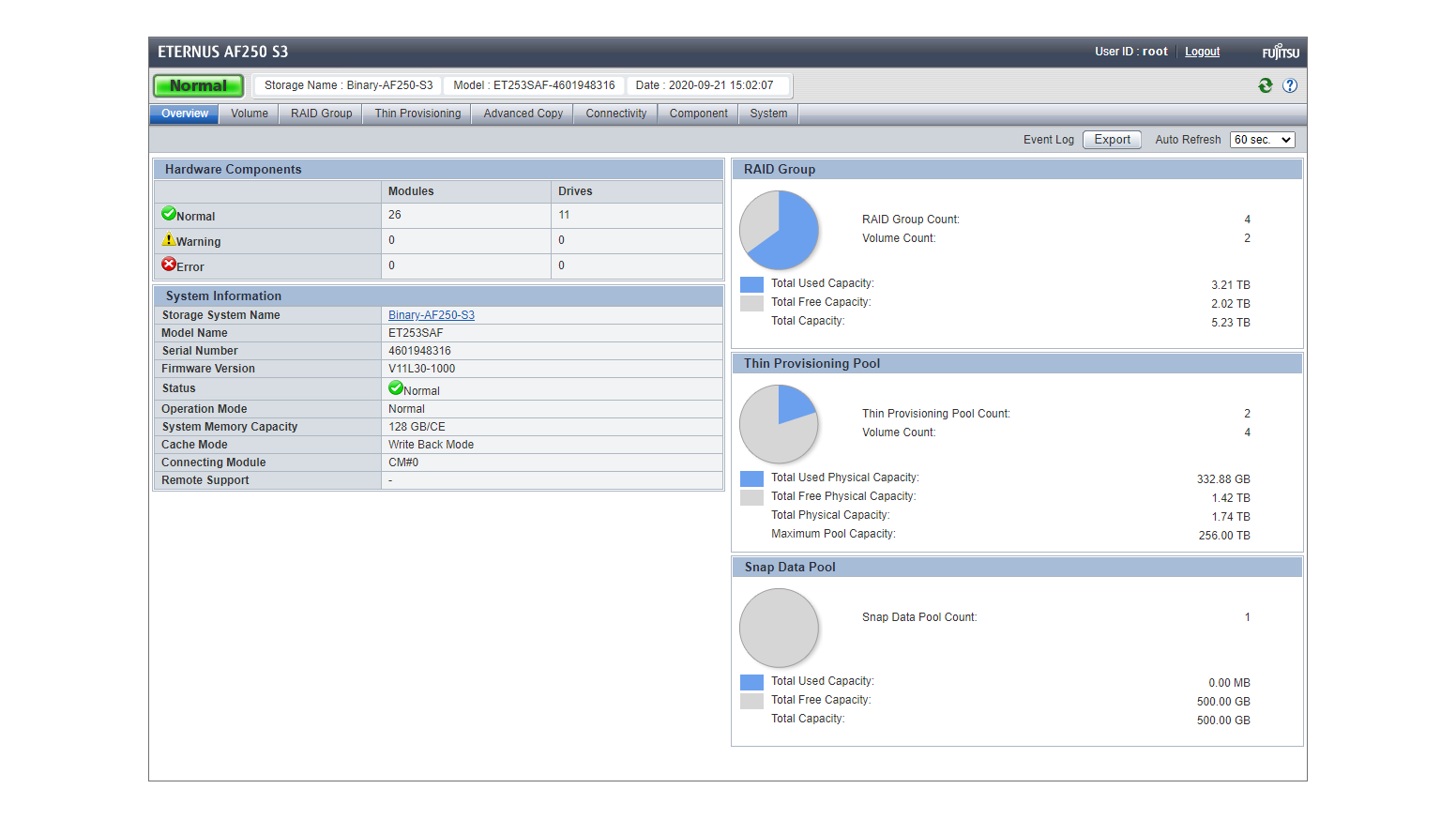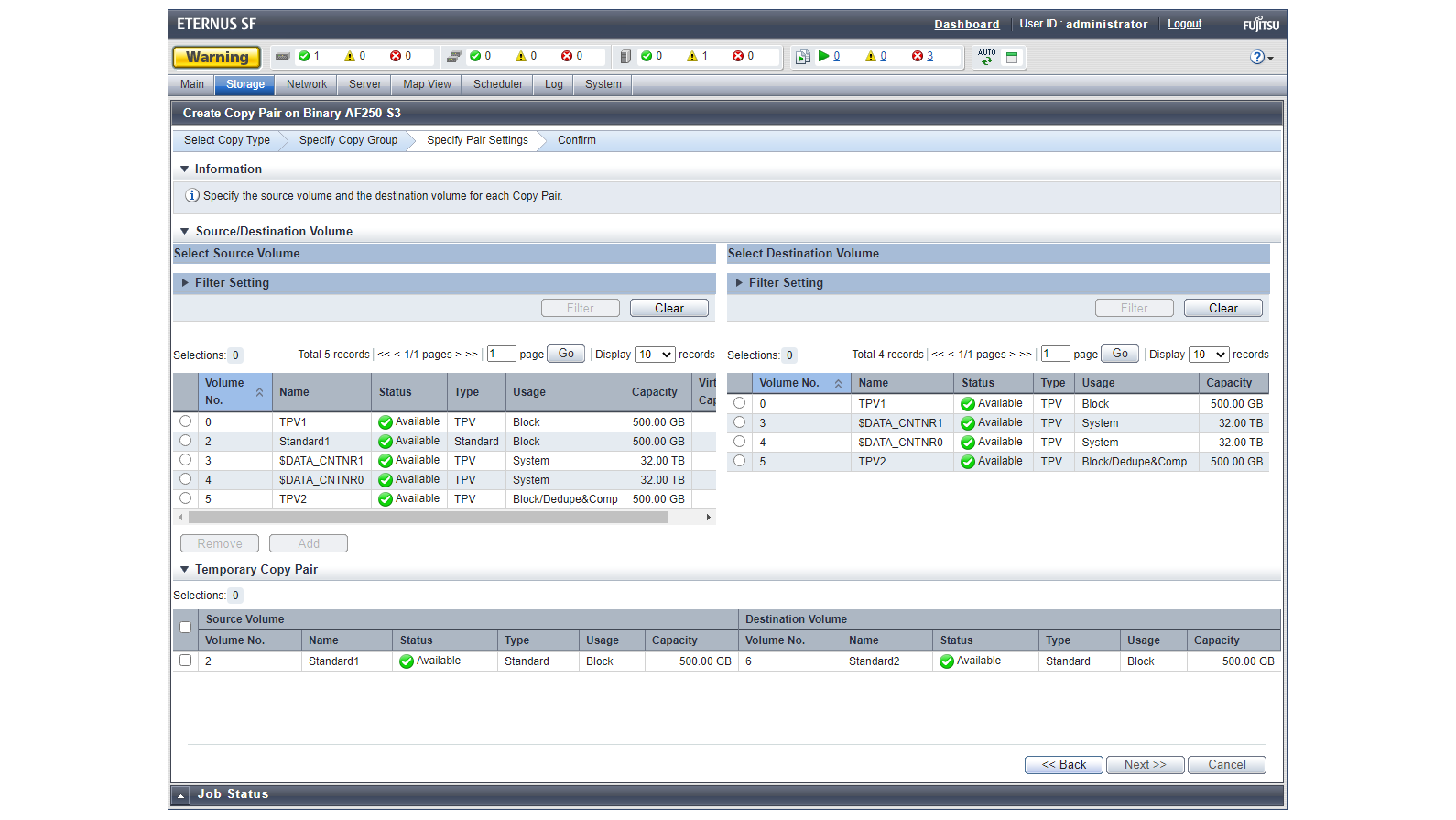Fujitsu Storage Eternus AF250 S3 review: Fast storage in a flash
An affordable all-Flash array with great performance


-
+
Great FC performance
-
+
Low latency
-
+
Very high expansion potential
-
+
Super redundant
-
+
Extensive data protection software suite
-
-
Software complex to configure and use

Fujitsu has always had a sharp focus on delivering affordable all-Flash arrays to enterprises and SMEs, but its latest family of Eternus AF appliances goes one step beyond. These aim to beat the competition soundly on value and claim an impressive ‘six nines’ of redundancy, along with a wealth of data protection features.
On review is the entry-level Eternus AF250 S3, a 2U rack appliance which supports SAS3 SSDs and comes with dual controllers functioning in active/active mode for transparent failover. It also sees a substantial hardware upgrade over the older AF250 S2, sporting a faster 8-core 2.2GHz Intel Xeon D CPU, while DDR4 cache memory receives a doubling in maximum capacity to 128GB per controller.
Extra features keep on coming; the new controllers can handle up to 8 ports of 32Gbps FC or 16 ports of 16Gbps FC or 10GbE iSCSI. Storage expansion is also vastly superior as the AF250 S3 supports up to 10 external drive enclosures for a total of 264 drives – the AF250 S2 only supports a single disk enclosure and a maximum of 48 drives.
The improved hardware gives a substantial performance boost, with Fujitsu claiming an increase over the AF250 S2 of nearly 40% to 600,000 IOPS for random read operations. Cache protection remains the same with the controllers incorporating Ni-MH batteries plus NVRAM to protect the cache contents in the event of a power failure.
Fujitsu Storage Eternus AF250 S3 review: Installation
For initial deployment, we pointed a browser at the primary controller’s remote access network port and followed the quick start wizard to configure basic details. These include the system hostname, administration security and the IP address of the maintenance port, which is used for general web management access and for the SF Express software.

It’s important to set up SNMP correctly on the array as SF Express uses this for all management. You need to create a new SNMP user on the array assigned with the ‘Software’ role and over on the SF Express host, add dedicated admin groups with management and monitoring privileges.
The appliance’s web console hasn’t changed from previous versions and you start by creating RAID Groups (RGs). The price we’ve shown includes two 960GB SAS SSDs but for testing, we fitted eleven 960GB SAS SSDs, which we used to create a single RAID10 RG with a global hot-spare.
For thin provisioned volumes (TPVs), you create a dedicated storage pool and as volume space gets used, the array dynamically assigns new blocks to it from the pool. Attention and warning capacity thresholds are applied to a pool and when they are reached, the appliance will send out an alert.
Inline deduplication and compression are included and can be applied only to TPVs. Another valuable feature is integral data encryption; you can request that this is carried by the controller’s firmware or use SEDs (self-encrypting drives).
Fujitsu Storage Eternus AF250 S3 review: Data protection
All volume cloning, snapshots and replication are configured using the SF Express software, which can manage multiple arrays from a central host. We installed it on a Windows Server 2019 system and logged into it with the local user we had previously created.

We’ve included the Storage Cruiser upgrade too, which enables data tiering, automated QoS (Quality of Service) and enhanced performance monitoring. This adds a lot of versatility - you could for example, enable QoS on an all-Flash tier for high-demand apps and use TPVs with deduplication and compression where the priority is on storage savings.
Next up is OPC (one point copy), which creates a one-off clone of a source volume to a local destination while QuickOPC clones a volume and updates it incrementally. Meanwhile, EC (equivalent copy) mirrors one volume to another in real-time on the same array while the REC (remote EC) performs this to a remote array for disaster recovery.
Create dedicated SDVs (snap data volumes) and you can use SnapOPC+ (one point copy plus) to take copy-on-write snapshots of selected source volumes. Capacity management is eased by the ability to create a dedicated SDV pool- so if an SDV runs out of space, it can take some from this until you increase the SDV’s size.
Fujitsu Storage Eternus AF250 S3 review: Performance
Our review system was supplied with two 16Gbps FC ports in each controller and for performance testing, we used a Dell PowerEdge T640 server running Windows Server 2019 and equipped with a quad-port ATTO Celerity FC-164P FC adapter.
Access controls are tight, and Fujitsu’s Affinity Groups manage connections between hosts, ports and LUNs. Our server’s four FC connections were automatically discovered by the appliance, so we put them all in one host group and linked them together with LUN and port groups.

You can modify a volume’s ALUA (asymmetric logical unit access) settings so we changed it to active/active for our mapped volume. This allowed us to achieve a high performance quad-port MPIO link to the server with all four FC paths active and optimised.
For sequential read and write operations, we recorded impressive Iometer rates of 39.1Gbits/sec and 32.4Gbits/sec which remained rock steady when we swapped to random operations. Dropping to Iometer 4KB block sizes returned equally good sequential read and write rates of 579,000 and 208,700 IOPS while our random tests saw 580,000 and 220,000 IOPS.
Fujitsu Storage Eternus AF250 S3 review: Verdict
Our only issue with Fujitsu’s Eternus AF arrays is their complicated deployment processes. There are a lot of features to manage and all too often, we found ourselves hunting through the web console, SF Express interface and copious software documentation to remind ourselves where they were lurking.
Even so, there’s no doubt the improved hardware specification has had a big impact on performance as the Eternus AF250 S3 is considerably faster than its predecessor. Combining this with the high expansion potential and low starting price makes this all-Flash array a good choice for demanding enterprises and SMEs.
Fujitsu Storage Eternus AF250 S3 specifications
| Chassis | 2U rack |
| Storage | 24 x SAS3 SSD hot-swap drive bays |
| Drives included | 2 x 960GB SAS SSDs |
| Power | 2 x 805W hot-plug PSUs with cooling fans |
| Controllers | Dual active/active controllers with the following: |
| CPU | 2.2GHz 8-core Intel Xeon D |
| Memory | 64GB DDR4 cache/BBU (max 128GB) |
| Array support | RAID0, 1, 10, 5, 6, 50, global/dedicated hot-spare |
| Data ports | 32Gbps FC (max 8) or 8/16Gbps FC, 10GbE iSCSI (max 16) |
| Network | Gigabit management port |
| Management | Web browser, SF Express |
| Expansion | Max 10 enclosures, 264 drives |
| Software | SF Express, Cruiser Standard/QoS, AdvancedCopy Manager Local/Remote |
| Warranty | 3 years on-site NBD |
Get the ITPro daily newsletter
Sign up today and you will receive a free copy of our Future Focus 2025 report - the leading guidance on AI, cybersecurity and other IT challenges as per 700+ senior executives
Dave is an IT consultant and freelance journalist specialising in hands-on reviews of computer networking products covering all market sectors from small businesses to enterprises. Founder of Binary Testing Ltd – the UK’s premier independent network testing laboratory - Dave has over 45 years of experience in the IT industry.
Dave has produced many thousands of in-depth business networking product reviews from his lab which have been reproduced globally. Writing for ITPro and its sister title, PC Pro, he covers all areas of business IT infrastructure, including servers, storage, network security, data protection, cloud, infrastructure and services.
-
 Cleo attack victim list grows as Hertz confirms customer data stolen – and security experts say it won't be the last
Cleo attack victim list grows as Hertz confirms customer data stolen – and security experts say it won't be the lastNews Hertz has confirmed it suffered a data breach as a result of the Cleo zero-day vulnerability in late 2024, with the car rental giant warning that customer data was stolen.
By Ross Kelly Published
-
 Women show more team spirit when it comes to cybersecurity, yet they're still missing out on opportunities
Women show more team spirit when it comes to cybersecurity, yet they're still missing out on opportunitiesNews While they're more likely to believe that responsibility should be shared, women are less likely to get the necessary training
By Emma Woollacott Published
-
 OpenAI wants developers using its new GPT-4.1 models – but how do they compare to Claude and Gemini on coding tasks?
OpenAI wants developers using its new GPT-4.1 models – but how do they compare to Claude and Gemini on coding tasks?News OpenAI says its GPT-4.1 model family offers sizable improvements for coding, but tests show competitors still outperform it in key areas.
By Ross Kelly Published